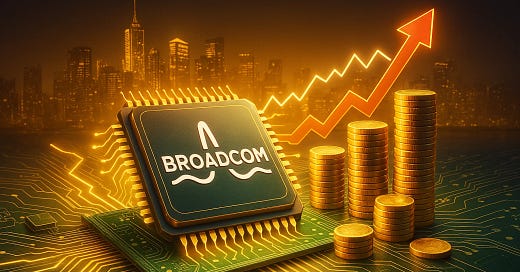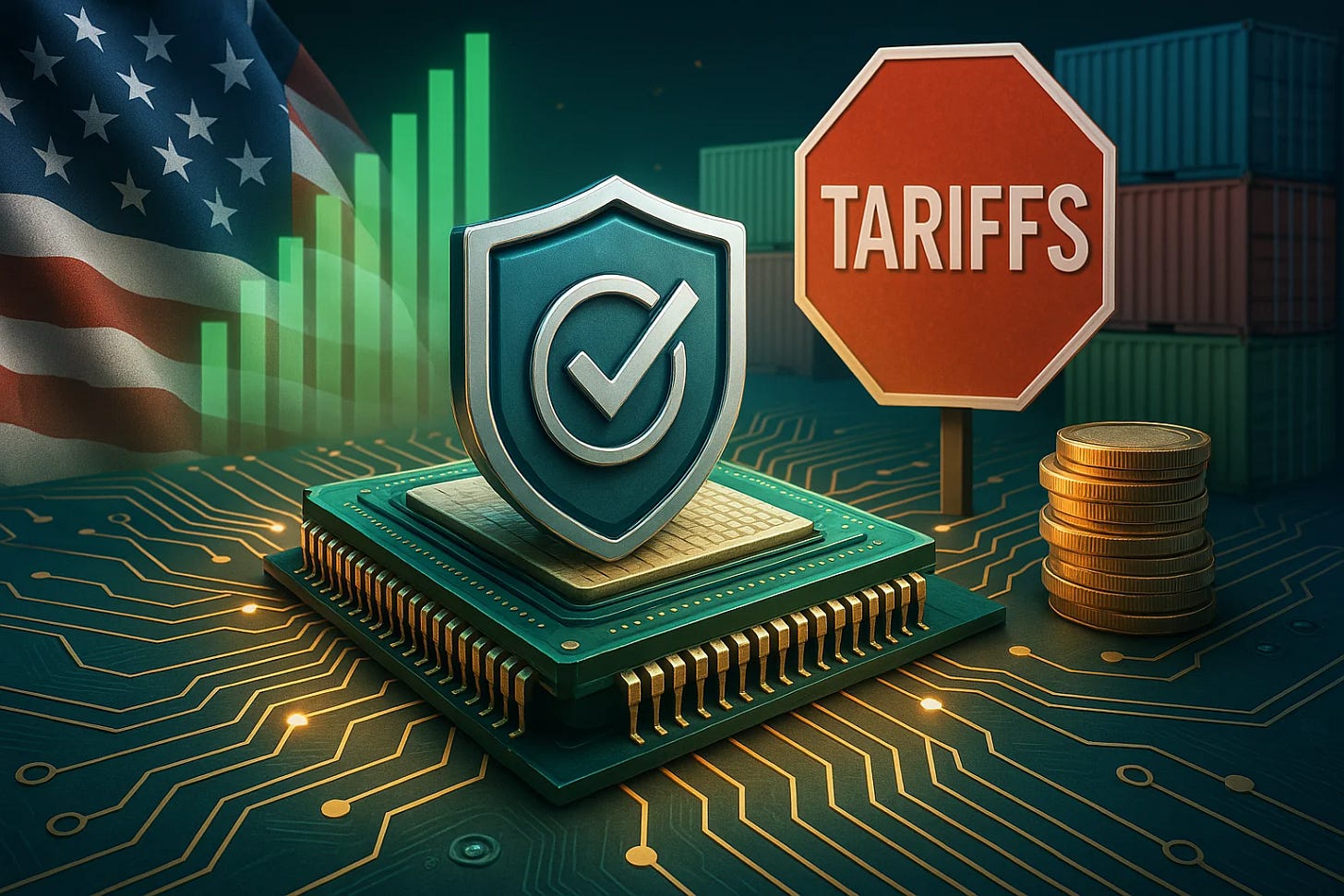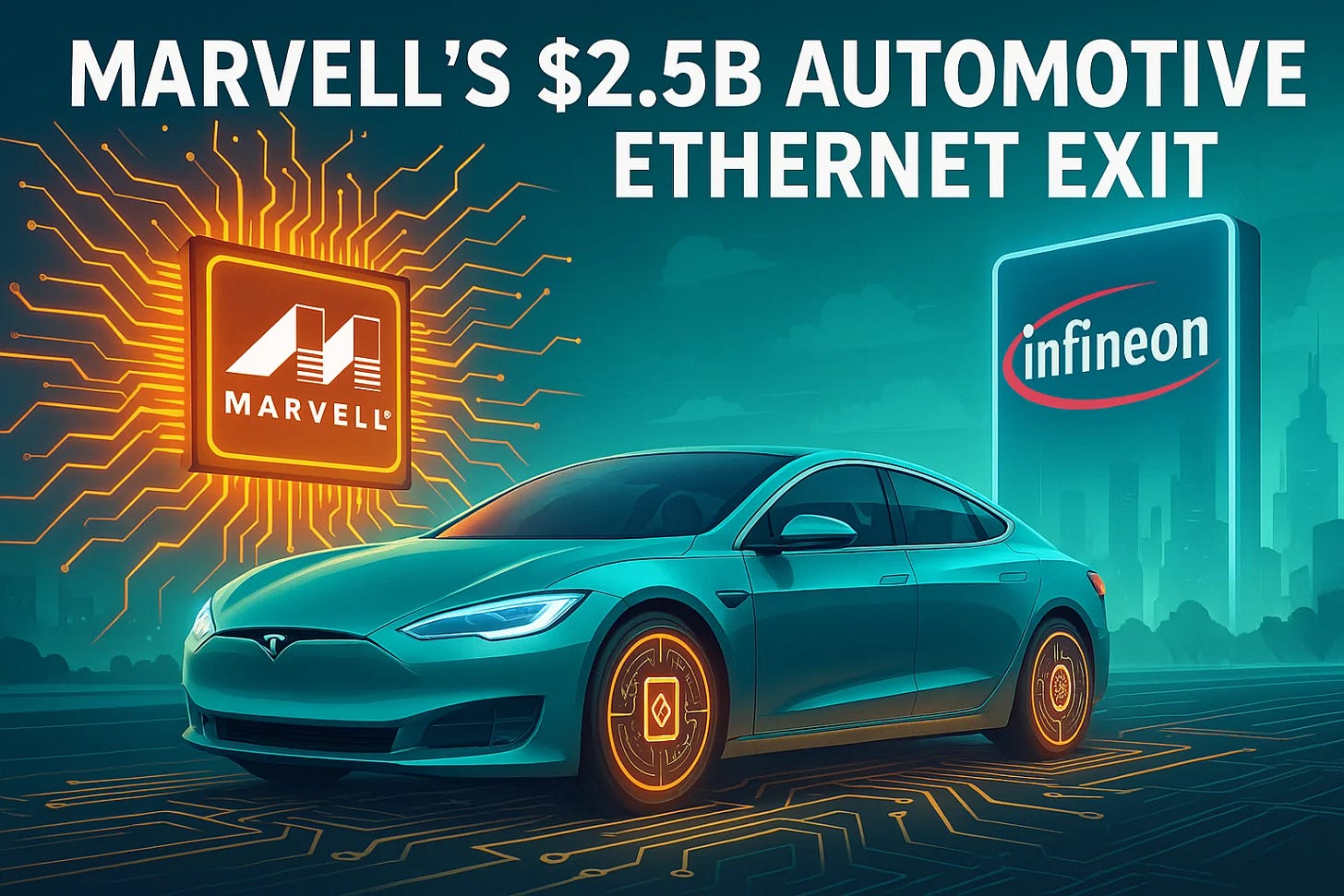💰 Broadcom’s Bold Buyback Boost
Welcome, AI & Semiconductor Investors,
Broadcom’s bold $10 billion buyback sends a powerful message of confidence, reaffirming its financial strength despite tariff turmoil and market volatility.
We also unpack Nvidia's tricky tariff exemptions and Marvell's strategic $2.5 billion automotive Ethernet exit—moves that could reshape the AI and semiconductor investment landscape. — Let’s Chip In
What The Chip Happened?
💰 Broadcom’s Bold Buyback Boost
🛡️ Tariff Tangles: Exemptions, Surprises, and 20% Workarounds
🚀 Marvell’s $2.5B Automotive Ethernet Exit
[DigitalOcean 2025 Investor Day: Driving Sustainable Cloud Growth]
Read time: 7 minutes
Broadcom Inc. (AVGO)
💰 Broadcom’s Bold Buyback Boost
What The Chip: On April 7, 2025, Broadcom announced a massive new $10 billion share repurchase authorization despite facing recent stock volatility and newly announced tariffs. This move signals management’s confidence in the company’s resilient semiconductor and infrastructure software business model.
Details:
🔑 Big Buyback: Broadcom’s Board authorized up to $10 billion in share repurchases through December 31, 2025, underscoring confidence in the company’s long-term financial health.
💰 Strong Cash Flow: “The new share repurchase program reflects the Board’s confidence in our strong cash flow generation,” said Kirsten Spears, CFO of Broadcom Inc.
📉 Stock Dip: Broadcom’s shares have fallen over 30% year-to-date, adding significance to this announcement as the market digests negative tariff news.
🚧 Tariff Turbulence: Recent tariffs announced in early April have weighed on semiconductor stocks, but Broadcom leadership still sees strong fundamentals and an “enabling” role in AI innovation.
🤖 AI Drive: Hock Tan, President and CEO of Broadcom Inc., highlighted the company’s position in “mission critical infrastructure software and enabling hyperscalers to drive innovation in generative AI.”
⚖️ Flexibility: The company can repurchase shares at its discretion, depending on share price, market conditions, and future acquisitions or strategic opportunities.
Why AI/Semiconductor Investors Should Care: Broadcom’s willingness to deploy capital into share repurchases now suggests management believes in the company’s long-term upside, especially in light of AI growth potential. Despite tariff challenges and stock volatility, Broadcom’s consistent cash flow generation and diversification may position it for resilience in a rapidly changing semiconductor landscape.
Moore Semiconductor Investing
📗 [NEW!!] Unlock Q4 Semiconductor Earnings --- 60% OFF (NEW EARNINGS)
What The Chip: Get a front-row seat to the financials shaping the semiconductor industry. This continuously updated e-book by Jose Najarro distills the latest Q4 quarterly insights—from wafer production trends to AI chip breakthroughs—into a single comprehensive resource.
Details:
🔵 Dynamic Updates: Start with giants like TSMC and ASML, then expand to 30+ companies as their Q4 2024 earnings roll in. Earnings are restarting!!
🔵 Broad Coverage: From traditional chipmakers to cutting-edge AI semiconductor players, get the full picture as it emerges.
Why AI/Semiconductor Investors Should Care: This evolving earnings handbook gives you a strategic edge. Understanding quarterly earnings data is crucial for gauging industry health, discovering new growth leaders, and aligning your investment approach with emerging technological waves.
Disclaimer: For educational and informational purposes only. Not financial advice. Consult with a qualified professional before making any investment decisions. Updates are only for the Quarter of Earnings.
Semiconductors (SMH)
🛡️ Tariff Tangles: Exemptions, Surprises, and 20% Workarounds
What The Chip: On April 2, 2025, the White House released a fact sheet confirming that semiconductors are exempt from President Trump’s newly announced reciprocal tariff plan. Despite this headline exemption, semiconductor companies—including Nvidia—face broader supply chain challenges and potential cost increases due to other product-level tariffs.
Details:
🔎 Exemption in Name Only: While pure semiconductors are spared, products containing these chips (like servers and electronics) still fall under tariffs as high as 34% for imports from China and 32% from Taiwan. This indirect effect can pinch Nvidia’s market if device-makers pass costs down the chain.
🏭 Supply Chain Shuffle: Many key materials and assembly processes for semiconductors aren’t exempt. Higher tariffs on manufacturing equipment and other components raise the cost of producing GPUs—even if the chips themselves are tariff-free.
🇺🇸 20% U.S. Content Advantage: Under the new rules, goods with over 20% U.S. content are only tariffed on foreign value, which might help companies that design chips in the U.S. This approach could reduce overall tariff costs if final assembly avoids high-tariff locations.
⚠️ Country of Origin: Customs law focuses on “substantial transformation” at the final assembly site. If that happens in China, the product is deemed Chinese-origin—even if 80% of parts come from elsewhere—potentially incurring tariffs as high as 54%.
🔧 Trump’s Push for Onshore: President Trump said, “If they desire a zero tariff rate, then they should produce their products right here in America.” This could accelerate existing trends toward U.S. manufacturing to sidestep these tariffs.
Why AI/Semiconductor Investors Should Care: This evolving tariff landscape could reshape both costs and supply chains for Nvidia and the entire semiconductor sector, impacting margins and pricing. With chip demand soaring, any shift in global manufacturing strategy or additional tariff burdens can influence long-term competitiveness and investment returns.
Marvell Technology (MRVL)
🚀 Marvell’s $2.5B Automotive Ethernet Exit
What The Chip: On April 7, 2025, Marvell Technology announced it will sell its Automotive Ethernet business to Infineon for a hefty $2.5 billion in cash. This move highlights Marvell’s ongoing strategy to double down on its core AI and data infrastructure offerings.
Details:
🔍 Big Ticket Deal: The business is expected to bring in $225–$250 million in fiscal 2026, making the purchase price of $2.5 billion an attractive premium for Marvell shareholders.
⚙️ Strategic Realignment: With data center solutions now driving about 75% of Marvell’s revenue (Q4 FY2025), this divestiture frees resources for the company’s faster-growing AI and data infrastructure segments.
💰 Financial Boost: The deal provides fresh capital for Marvell’s R&D and potential acquisitions. Management hinted it could also be used for stock buybacks to enhance shareholder value.
🤝 Better Automotive Home: Infineon, known for its automotive semiconductor expertise, is well positioned to scale the Brightlane® Automotive Ethernet portfolio. Matt Murphy, Marvell’s Chairman and CEO, said, “With Infineon’s optimized platform for automotive applications, we are confident the Automotive Ethernet business is well positioned for continued growth and success.”
⚡ Shifting Focus: Marvell’s long-term growth increasingly hinges on AI-driven solutions, with management reporting a strong pipeline of AI accelerator and CPU design wins from major hyperscalers.
Why AI/Semiconductor Investors Should Care: By offloading a smaller piece of its portfolio, Marvell can sharpen its focus on high-margin, high-growth AI and data center opportunities. Investors stand to benefit from both the immediate cash influx and the expanded commitment to sectors seeing robust demand. This transaction underscores a market trend where semiconductor players are reshuffling to capture stronger positions in AI-driven growth areas.
Youtube Channel - Jose Najarro Stocks
[NEW] Semiconductor Q4 Earnings Book — 60% OFF
X Account - @_Josenajarro
Disclaimer: This article is intended for educational and informational purposes only and should not be construed as investment advice. Always conduct your own research and consult with a qualified financial advisor before making any investment decisions.
The overview above provides key insights every investor should know, but subscribing to the premium tier unlocks deeper analysis to support your Semiconductor, AI, and Software journey. Behind the paywall, you’ll gain access to in-depth breakdowns of earnings reports, keynotes, and investor conferences across semiconductor, AI, and software companies. With multiple deep dives published weekly, it’s the ultimate resource for staying ahead in the market. Support the newsletter and elevate your investing expertise—subscribe today!
[Paid Subscribers] DigitalOcean 2025 Investor Day: Driving Sustainable Cloud Growth
Date of Event: April 4, 2025
Executive Summary
*Reminder: We do not talk about valuations, just an analysis of the earnings/conferences
DigitalOcean Holdings, Inc. (“DigitalOcean”) hosted its 2025 Investor Day on April 4, 2025, at the New York Stock Exchange, where management provided a comprehensive update on the company’s financial standing, product innovation efforts, and strategic outlook. The company currently boasts an Annual Recurring Revenue (ARR) run rate of around USD 820 million, serves over 638,000 customers, and reported a strong adjusted EBITDA margin in the mid-30s range.
Key developments centered on DigitalOcean’s push to capture a larger share of digital-native enterprises by offering streamlined cloud solutions and expanding into the artificial intelligence (AI) space. Notably, Chief Executive Officer (CEO) Padmanabhan (“Paddy”) Srinivasan emphasized the importance of enhancing both the product-led growth motion and complementary go-to-market strategies to accelerate sales among larger accounts.
One standout aspect of the event was the company’s new “do.next” initiative, which leverages AI to simplify cloud operations, reduce complexities, and democratize AI capabilities for small and mid-sized businesses. According to Srinivasan, the mission is “to make advanced cloud capabilities intuitive, accessible, and cost-effective so builders can focus on innovation rather than infrastructure.” Meanwhile, Chief Financial Officer (CFO) Matt Steinfort reiterated the long-term plan to balance growth and profitability, as illustrated by the Weighted Rule of 40 framework, adding that “we intend to drive our revenue growth to 18%–20% by 2027 while maintaining strong free cash flow margins.”
Growth Opportunities
Targeting Digital-Native Enterprises
DigitalOcean’s senior leadership underscored the importance of targeting digital-native enterprises—organizations whose core products and services run entirely on cloud infrastructure. Historically, these customers start with small monthly spend and rapidly grow as they scale. “Digital-native enterprises need a cloud partner that is large enough to scale with them, but small enough and hungry enough to care about their success,” said Srinivasan. Currently, DigitalOcean counts more than 165,000 such businesses in its overall user base, with 500 of them spending at least USD 100,000 annually.







